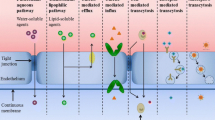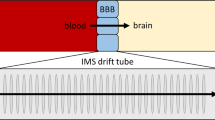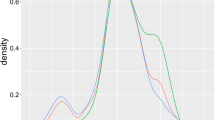Abstract
Quantitative information of solvation and transfer free energies is often needed for the understanding of many physicochemical processes, e.g the molecular recognition phenomena, the transport and diffusion processes through biological membranes and the tertiary structure of proteins. Recently, a concept for the localization and quantification of hydrophobicity has been introduced (Jäger et al. J Chem Inf Comput Sci 43:237–247, 2003). This model is based on the assumptions that the overall hydrophobicity can be obtained as a superposition of fragment contributions. To date, all predictive models for the logP have been parameterized for n-octanol/water (logP oct ) solvent while very few models with poor predictive abilities are available for other solvents. In this work, we propose a parameterization of an empirical model for n-octanol/water, alkane/water (logP alk ) and cyclohexane/water (logP cyc ) systems. Comparison of both logP alk and logP cyc with the logarithms of brain/blood ratios (logBB) for a set of structurally diverse compounds revealed a high correlation showing their superiority over the logP oct measure in this context.





Similar content being viewed by others
References
Leo A, Hansch C, Elkins D (1971) Chem Rev 6:71
Caron G, Ermondi G (2005) J Med Chem 48:3269
El Tayar N, Tsai RS, Testa B, Carrupt PA, Leo A (1991) J Pharm Sci 80:590
Abraham MH, Chadha HS, Whiting GS, Mitchell RC (1994) J Pharm Sci 83:1085
Pixner P, Heiden W, Merx H, Möller A, Moeckel G, Brickmann J (1994) J Chem Inf Comput Sci 34:1309–1319
Jäger R, Schmidt F, Schilling B, Brickmann J (2000) J Computer-Aided Mol Des 14:631–646
Jäger R, Kast SM, Brickmann J (2003) J Chem Inf Comput Sci 43:237–247
Goodford PJ (1996) Chemometrics 10:107
Ghose AK, Crippen GM (1986) J Comp Chem 7:565–577
Viswanadan VN, Ghose AK, Revankar GR, Robins RK (1989) J Chem Inf Comput Sci 29:163–172
Ghose AK, Viswanadan VN, Wendoloski JJ (1998) J Phys Chem A 102:3762–3772
No KT, Kim SG, Cho KH, Scheraga HA (1999) Biophys Chem 78:127
Cruciani G (2006) Molecular interaction fields. Wiley-VCH
Gasteiger J, Rudolph C, Sadowski J (1992) Tetrahedron Comput Meth 3:537
El Tayar N, Tsai RS, Testa B, Carrupt PA, Hansch C, Leo A (1991) J Pharm Sci 80:744
Ganellin CR (1991) Uses of partition coefficients by brain penetration applied to the design of H2-receptor histamine antagonists. Elsevier
Abraham MH, Chadha HS, Mitchell RC (1994) J Pharm Sci 83:1257
Chadha HS, Abraham MH, Mitchell RC (1994) Bioorg Med Chem Lett 2511:1085
Young RC, Mitchell RC, Brown TH, Ganellin CR, Griffiths R, Jones M, Rana KK, Saunders D, Smith IR, Sore NE, Wilks TJ (1988) J Med Chem 31:656
Young RC, Ganellin CR, Griffiths R, Mitchell RC, Parsons ME, Saunders D, Sore NE (1993) J Med Chem 28:201
Wichmann K, Diedenhofen M, Klamt A (2007) J Chem Inf Model 47:228
Platts JA, Abraham MH, Zhao YH, Hersey A, Ijaz L, Butima D (2001) Eur J Med Chem 36:719
Subramanian G, Kitchen DB (2003) J Computer-Aided Mol Des 17:643
Fu X, Song Z, Liang W (2005) Internet Electron J Mol Des 4:737
Rishton GM, LaBonte K, Williams AJ, Kassam K, Kolovanov E (2006) Curr Opin Drug Dis Dev 9:303
Author information
Authors and Affiliations
Corresponding author
Electronic supplementary material
Below is the link to the electronic supplementary material.
Rights and permissions
About this article
Cite this article
Zerara, M., Brickmann, J., Kretschmer, R. et al. Parameterization of an empirical model for the prediction of n-octanol, alkane and cyclohexane/water as well as brain/blood partition coefficients. J Comput Aided Mol Des 23, 105–111 (2009). https://doi.org/10.1007/s10822-008-9243-2
Received:
Accepted:
Published:
Issue Date:
DOI: https://doi.org/10.1007/s10822-008-9243-2




